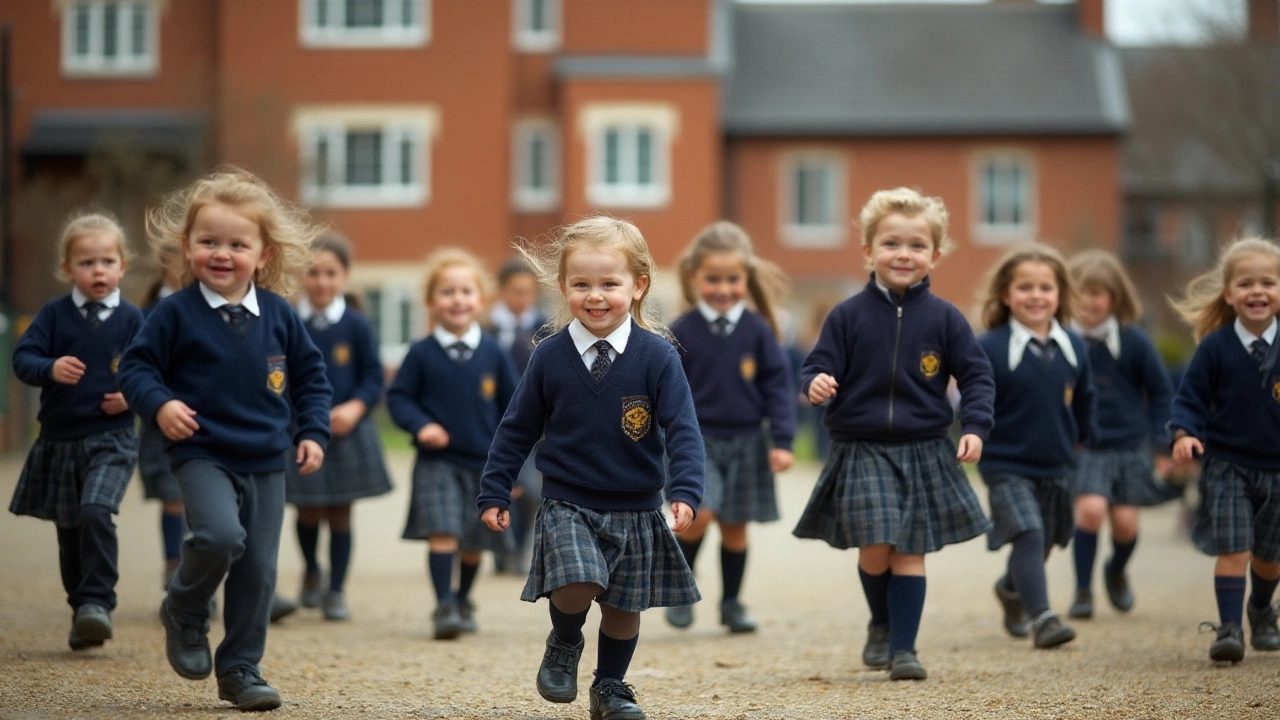How School Uniforms Can Help Parents Cut Costs

- Cleo Fairchild
- 14 January 2025
- 0 Comments
Ever feel like your family wardrobe expenses are spiraling out of control? You're certainly not alone. Many parents find themselves dipping deep into their pockets to keep up with the ever-changing fashion trends of the schoolyard. This is where school uniforms can step in as a practical remedy.
At first glance, the initial purchase of school uniforms may seem like just another expense on the ever-growing list, but a closer look reveals that these structured outfits hold great potential for savings. Not only do they wear well throughout the year, but they also level the playing field for all students, minimizing the pressures of sartorial one-upmanship.
In this article, we'll delve into the various ways school uniforms can actually save money for parents, exploring the hidden benefits that often go unnoticed. The simplicity they bring is not just in the closet, but also in reduced stress and seamless morning routines. Let's discover how these simple garments can make life a whole lot easier—and cheaper—for families.
- The Cost of Regular Clothing
- Durability and Longevity of Uniforms
- Streamlining Wardrobe Choices
- Reducing Peer Pressure and Bullying
- Long-term Financial Benefits
The Cost of Regular Clothing
Imagine the typical scenario of walking into a store, list in hand, only to find yourself overwhelmed by the array of choices. Every season brings with it a fresh wave of trends that are hard to ignore, especially if you have fashion-savvy kids who want to fit in with their peers. The cost of keeping up with these trends can become quite burdensome on the household budget, especially when styles change faster than the seasons themselves. Not only are you buying clothes for everyday wear, but you're also picking up special attire for events, holidays, and the ever-important "cool" factor in a school setting. This doesn't even begin to touch on replacement costs for wear and tear, as regular clothes often lack the durability found in school uniforms.
The financial burden doesn't stop at simply buying clothes. Many households often find themselves shelling out more money for laundry and maintenance. Regular clothing requires more frequent washing to keep them fresh and presentable—a chore that might be easier on a standard schedule with uniforms. Consider this: a study reported by the Atlantic noted that families could save upwards of 10% on their annual clothing budget by simply streamlining their wardrobe choices to include uniforms or limited options.
A spokesperson from the Family Education Trust once remarked, "School uniforms remove the uncertainty of daily fashion choices and significantly reduce the financial strain on parents."
Moreover, when you take into account the accessories and extras, like shoes, backpacks, and seasonal wear, the costs continue to climb. These are the hidden expenses that folks often overlook. The pressure to ensure children's clothing is always fresh and current becomes a financial commitment that not every family can comfortably handle. Schools requiring monthly contributions for casual clothes days can sneak up as well. As families strive to meet their children's clothing desires, this additional strain may lead to cutting costs in other vital areas, impacting the family's overall financial health. Switching to a school uniform approach can substantially limit these variable costs, thus providing a welcome relief and giving parents one less thing to worry about financially.
Durability and Longevity of Uniforms
When considering school uniforms, one of the standout benefits is their remarkable durability. These clothes aren't just fashioned for the sake of appearances; they are made to endure the rigors of school life. Typically, school uniforms are crafted from high-quality fabrics that are designed to withstand the wear and tear that comes with active children. This means fewer frayed seams and fewer mysterious stains that refuse to budge.
Take, for instance, the common uniform dress shirt. These garments often come reinforced at stress points like the elbows and shoulders, making them last much longer than a regular shirt you might pick up from a fast-fashion outlet. The same applies to pants and skirts that are double-stitched to avoid tears during physical play or desk time.
If you think about the lifespan of regular clothes compared to uniforms, the latter usually has the upper hand. Regular clothes might look vibrant and trendy, but they seldom survive more than a year. By contrast, school uniforms are built to last several years through repeated washes and everyday use. One study noted that, on average, a single uniform set can last from two to three school years, which is a blessing for any budget-conscious parent.
"School uniforms offer an unmatched level of practicality and uniformity, providing parents with economic relief due to their longevity," noted education expert Dr. Maria Thompson.
Another hidden advantage of the sturdiness of school uniforms is their ability to be handed down to younger siblings or even resold in second-hand markets. Parents often find themselves at a financial crossroads when figuring out how to outfit the second child, but the durable nature of school uniforms offers a simple solution. The initial investment pays off, saving money for the entire family.
Detailed statistics support this advantage. According to recent surveys, parents report a significant 30% savings in household spending by choosing uniforms over everyday fashion options. It's easy to see why: by opting for durable school outfits, parents reduce the need for frequent purchases of casual wear for school days. In a world filled with ever-growing expenses, every bit helps.

Streamlining Wardrobe Choices
Choosing outfits for school each day can be a thrilling but time-consuming game for both parents and children. The process demands not only selecting clothes that fit the taste of the day but also adapting to unpredictable weather and seasonal changes. It’s a small daily theatre production where parents play the stylists, and children are the stars. With the introduction of school uniforms, families can remove costume drama from their morning routines, providing a simple solution that saves valuable time and reduces stress.
Uniforms offer consistency, leading to smoother mornings, with no fuss over what to wear. Instead of a pile of rejected outfits strewn across the bed, children find their uniform in its assigned place, ready to wear. This efficiency doesn’t just benefit morning routines; it extends into laundry management, with simpler decisions about washing and caring for outfits during the week. Knowing that the clothes will be functional and appropriate every day means more family time in the evenings, freed from the shackles of garment mysteries.
This style of clothing can reduce the anxiety that comes from the endless combination possibilities, allowing for focus on more important tasks. From a practical perspective, while trendy clothing might look appealing, uniforms are often designed with durability in mind. This simplifies wardrobe management, eliminating the cycle of buying new clothing items due to wear and tear or changing tastes. As psychologist Dr. Nadia Mayo noted in her article "Clothing and Psychology", "Choices, when eliminated in certain areas, can significantly reduce a person's daily decision fatigue."
"By standardizing attire, uniforms not only save money but also provide psychological comfort and simplicity—a crucial factor in a child's well-being," states Dr. Nadia Mayo from the Journal of Child Development.
Moreover, by narrowing choices, uniforms help manage clothing budgets more efficiently. Instead of purchasing an extensive variety of attire to cover all possible occasions and social scenarios, parents can focus their financial resources on a few well-made pieces. This approach does not just amplify savings but also establishes an understanding in families that quality surpasses quantity. Statistics show households save approximately 20% on clothing costs annually by opting for school uniforms. The bypassed need for a seasonal refresh of casual clothes can make a significant difference in the family budget.
Adopting this clothing practice may foster a sense of unity among students and reduce pressure to wear specific brands or trends, strengthening a focus on school and relationships, not attire. As children navigate the journey of education, the simplicity of not having to decide their outfit every day frees them from needless distractions, leaving them invigorated and focused on their schooling. In this way, school uniforms support a healthier learning environment by taking away the emphasis on what to wear, replacing it with clarity and purpose.
Reducing Peer Pressure and Bullying
Imagine the typical frenzy of preparing for a new school year. The ritual often starts with shopping for clothes that will meet both the approval of parents and the socially savvy students. The pressure is on to pick outfits that adhere to a constantly moving target of acceptable fashion. This is where the idea of school uniforms becomes quite compelling. They strip away the complexities of fashion statements, allowing students to focus on their studies without the constant anxiety of keeping up with peers. By donning a similar outfit, students are free from the judgment that comes with clothing choices. This freedom from judgment can significantly lower levels of bullying, which too often centers around appearance and perceived socio-economic status.
Kids are highly susceptible to peer pressure, and unfortunately, a significant part of the school experience can involve navigating the tricky landscape of social acceptance. A uniform can erase visible distinctions that might otherwise become points of peer comparison and ridicule. According to a study by the National Association of Elementary School Principals, about 86% of school leaders have witnessed a reduction in bullying incidents once uniforms were introduced. This finding should not be underestimated nor trivially dismissed, given how such environmental changes can cultivate a more cohesive and supportive school atmosphere.
Uniforms can act as a great equalizer, promoting inclusivity by ensuring that external appearances are standardized across the student body. As students wear the same attire, it allows them to shine through their character, rather than through their wardrobes. This shift in focus helps diminish the emphasis on material wealth—often displayed through trendy clothing—which can cause divisions and form cliques. By leveling the playing field, uniforms foster friendship formation based on more personal values like kindness and shared interests.
Parents and educators alike have long advocated for the advantages that come with the uniform policy. An insightful observation from Dr. Danielle Spencer, a renowned child psychologist, indicates that children in schools with uniforms report feeling less pressured to dress a certain way. She states:
"Uniforms help students concentrate on their work by removing distractions caused by superficial differences."This comment highlights that the psychological effects extend beyond simply preventing bullying, by actively cultivating a setting where children can focus more intently on their educational journey.
Implementing school uniforms doesn’t just combat bullying; it paves the way for a healthier, more positive peer environment. When fashion statements are muted, students can divert energy into developing interests and skills. To summarize, uniforms can open the door to a school experience where learning and personality define one's identity far more than the labels or logos stitched onto clothing. By ensuring that every child feels a part of the team's fabric, schools can play a pivotal role in reducing peer pressure-related stress, setting the stage for a more inclusive society both inside and outside the classroom.

Long-term Financial Benefits
When considering the long-term financial benefits of school uniforms, it becomes clear that these garments provide more than just sartorial uniformity—they can significantly bolster a family's budget over time. School uniforms eliminate the need for a fully-stocked wardrobe of trendy clothing each school year. Instead of purchasing a range of outfits for different seasons and school events, parents can invest in a few durable, versatile school uniforms that can be worn repeatedly. This can cut annual clothing expenses by a significant margin.
Take for example, the case study of Oxford Preparatory Academy, where the adoption of a uniform policy reportedly saved each family an average of $150 per child annually. This savings stemmed from reducing the need to buy multiple non-essential clothing items and limiting impulse purchases driven by changing fashion trends. With fewer clothing options required, families can focus on purchasing a limited high-quality set of uniforms, thus ensuring durability and cost-effectiveness without compromising on quality. An interesting fact is that uniforms can often last longer due to their robust fabric and design meant to withstand frequent washing and daily wear.
Moreover, when children wear uniforms, there is less pressure on them to follow expensive fashion trends, which indirectly saves additional money for the family. This can also pave the way for more balanced spending, allocating funds to extracurricular activities or educational tools that contribute to a child's growth and learning. A 2017 study published in the Uniformed Press Journal found that schools with a uniform policy showed a 42% decrease in bullying incidents, which not only enhances the school environment but also reduces expenditures related to supporting children in stress-related conditions outside of school.
According to the National Association of Elementary School Principals, "Uniforms bridge the economic divide between students, allowing them to focus on what matters most: their education."
Another financial advantage stems from the predictable nature of uniform costs. Unlike regular fashion purchases, where new trends and styles emerge each season, the expenses for uniforms remain relatively stable. This predictability allows parents to budget more effectively, planning their finances with predictability. The expenses are not just limited to savings on clothing; they extend to time saved for parents and students, removing the daily decision of 'what-to-wear'. In households where time is money, the cumulative effect of a streamlined morning routine can be a financial boon in its own right.
To summarize, the long-term financial benefits of school uniforms are multi-fold. From significant savings in wardrobe expenses to reduced peer pressure related costs, to improved budgeting through predictable expenses, they afford families a unique set of financial advantages. This translates not only into enhanced savings but also contributes to an enriching environment where children can thrive academically, away from the societal pressures of the fashion industry.


